7 main causes of white bloom on cucumbers and leaves
Almost every gardener has to deal with a white bloom on the leaves of cucumbers, their stems or fruits. The pathology is mainly of a fungal nature - plant tissues infect fungi that provoke the appearance of whitish, yellow and gray pubescent plaque. Let's figure out why a white bloom appears on cucumbers, how dangerous it is, and whether powerful chemical agents are always needed to get rid of it.
The content of the article
Causes of white bloom on leaves, stems and cucumbers
Cucumber is one of the most popular vegetable crops among gardeners. But often, when growing, you have to face troubles in the form of white bloom on the stems, leaves and fruits. The reasons for this phenomenon lie in:
- sharp changes in the average daily temperature;
- long rains;
- watering with cool water;
- dense planting;
- high humidity in the greenhouse;
- violation of the rules of agricultural technology (weeding, loosening);
- lack of sunlight;
- excess nitrogen in the soil;
- lack of phosphorus and potassium.
Such disturbances in crop cultivation lead to the development of fungal diseases and the spread of insect pests.
Diseases and pests causing white bloom
Diseases, causing the appearance of a whitish or yellow bloom on the leaves of cucumbers, are mainly of a fungal nature (powdery mildew, peronosporosis, white rot, ascochitosis). White mosaic refers to viral diseases.
A spider mite that feeds on plant tissues also leads to the appearance of white spots on the leaves - the result of a violation of photosynthesis in the damaged areas.
Powdery mildew
Powdery mildew (ash, linen) - a fungal disease that occurs when a plant is infected with ectoparasites. In late May - early June, a whitish mycelium begins to develop on young shoots and leaves. Small drops of sticky, cloudy dew appear on the plants.
The pathogen overwinters in the upper layers of the soil, on plant debris, and with the onset of spring it spreads from the lower leaves up the stems.
Signs:
- whitish bloom on leaves and stems;
- brown balls inside plaque;
- dew drops on foliage;
- dry, twisted leaves;
- rot on fruits.
Without treatment, plaque thickens, becomes brown and spreads throughout the plant. Cucumbers look like they are covered in mold. These symptoms indicate the last stage of the disease. Treatment in this case is pointless.
In the photo - powdery mildew.
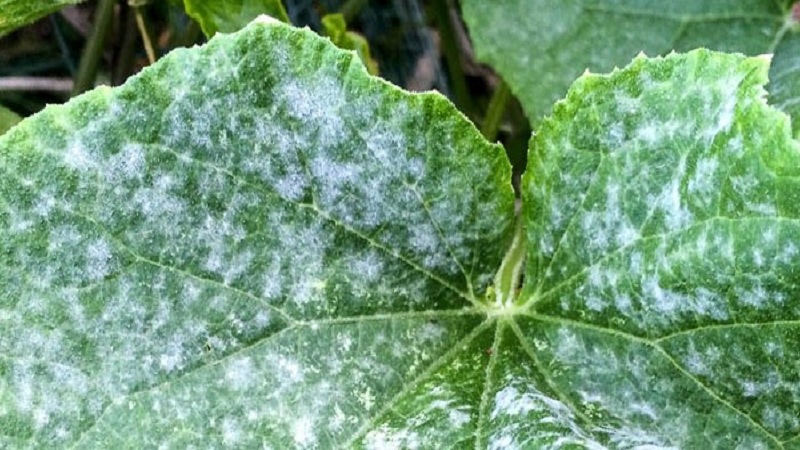
The table shows effective folk methods of dealing with powdery mildew.
| Recipe | Application |
| 10 l of water, 1 l of yogurt, kefir, milk whey. | Daily processing of plantings is allowed until the disease is completely eliminated. |
| 1 liter of water, 0.3 tsp. soda ash, 25 ml of liquid soap. | Planting processing should be carried out every 7 days. |
| Insist 1 liter of wood ash in 5 liters of boiling water for a day. | Bushes processing every 7 days. |
| Infusion of mullein 1:10, insist 3 days | Water at the root in the evening every 7 days. |
| Insist 100 g of dried horsetail in 10 liters of water for 24 hours, then boil over low heat for 2 hours, strain and cool. Dilute 1: 5 with water. | Process the bushes every 7 days. |
| Pour 0.5 buckets of marigold inflorescences with warm water, leave for two days, add 50 g of soap shavings. | Process the plants twice a week. |
Effective chemicals:
| Name | Application | Toxicity |
| "Topaz" | Dissolve 2 ml in 10 liters of water and add another 10 liters.The first treatment is carried out after the appearance of 8-10 true leaves, the second - at the beginning of flowering, 10 days after the first. | Not phytotoxic, not dangerous for birds, fish, beneficial insects and humans. |
| Fundazol | Dissolve 10 g in 10 liters of water. Carry out processing at least three times, every 10 days. | Moderately toxic to insects and humans. |
| "HOM" | Dissolve 40 g of powder in 10 l of water, add 100 ml of skim milk. Spray once a week in the evening. | Not phytotoxic, not dangerous for birds, fish, beneficial insects and humans. |
| "Speed" | Dissolve 2 ml in 10 liters of water, carry out three treatments with an interval of 10-12 days. | Not phytotoxic, not dangerous for birds, fish, beneficial insects and humans. |
| "Tiovit Jet" | Dissolve 30 g in 10 liters of water. Process the bushes 2-3 times per season. | Not phytotoxic, not dangerous for birds, fish, beneficial insects and humans. |
False dew (downy mildew)
Peronosporosis, or downy mildew, appears as white-yellow oily spots on cucumber leaves. As the disease progresses, the back of the leaves is covered with a purple bloom. The spots gradually grow and merge. Leaves wrinkle, dry and die off. Without treatment, peronosporosis can completely destroy the planting of cucumbers.
Reference. Downy mildew manifests itself only under favorable conditions for it - prolonged rains, irrigation with cold water, an excess of moisture in the soil.

Folk remedies against peronosporosis:
| Recipe | Application |
| 5 liters of water, 40 g of soda, 50 g of soap shavings. | Spray the soil and plants 4 times per season at intervals of 7 days. |
| 1 liter of skim milk, 40 drops of iodine, 25 g of liquid soap. | Spray cucumbers regularly throughout the growing season at intervals of 10 days. |
| Bring 0.5 kg of onion husks and 10 liters of water to a boil and leave for 5-7 days. | The treatment should be carried out 3-5 times a month until the symptoms disappear. |
The table lists the chemicals for downy mildew.
| Name | Application | Toxicity |
| "Acrobat MC" | Dissolve 50 g in 10 liters of water. Carry out the treatment at the first signs of illness, repeat after 2 weeks. | Not toxic to birds, fish and humans. |
| "Alirin B" | 2 tab. dissolve in 10 liters of water - for watering under a bush.
1 tab. for 1 liter of water - for spraying plants. The frequency of treatments is 2-3 times per season. |
|
| "Oxyhom" | 30 g per 10 liters of water. Spray plants in the evening. The frequency of treatments is 3 times per season with an interval of 15 days. | |
| "Ordan" | 25 g per 10 liters of water. Carry out the treatment at the first signs of illness, repeat after 2 weeks. |
White rot (sclerotinia)
The causative agent of white rot - sclerotinia marsupial fungus. Spores penetrate plant tissues and provoke mycelium development. The result is a cotton-like white bloom on cucumbers, stems and leaves. The affected areas become watery, the tips of the shoots and leaves wither and die off.
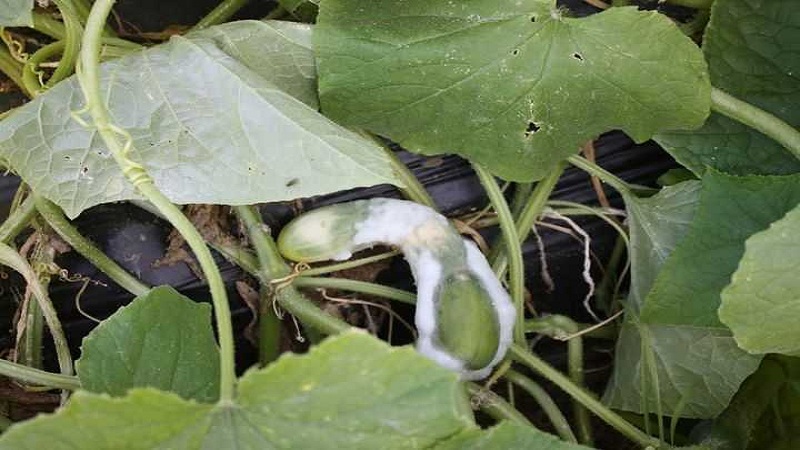
The table contains effective folk remedies.
| Recipe | Application |
| 1 liter of milk, 1 tbsp. l. shavings of laundry soap, 30 drops of iodine, 10 liters of water. | Treat bushes abundantly 3-4 times a week. |
| 10 liters of water, 8 tbsp. l., 4 tsp. potassium permanganate, 1 tbsp. l. shavings of soap. | Process the planting every 7 days. |
| Mix wood ash and crushed chalk 1: 1, add water to obtain a thick porridge. | Cut the affected leaves and stems, coat the cut site with the resulting mass. |
White rot chemicals:
| Name | Application | Toxicity |
| Abiga Peak | 50 ml for 10 liters of water. Treat the plants 3 times within 20 days. | Not toxic to humans and the environment. |
| "Acrobat MC" | 20 g for 5 liters of water. Carry out the treatment 2 times with an interval of 10 days. | |
| Ridomil Gold | 25 g per 10 liters of water. Treat the plants 3 times every 7 days. |
Gray rot
Gray rot - a disease caused by the fungus Botrytis cinerea. As the disease progresses, a whitish bloom with a gray tint appears on the fruits, leaves and stems. The affected areas rot and die off. Cucumbers become watery inside and are covered with a gray, cannon bloom.
Folk remedies are effective only at the first signs of the disease. They are also used for preventive treatments.
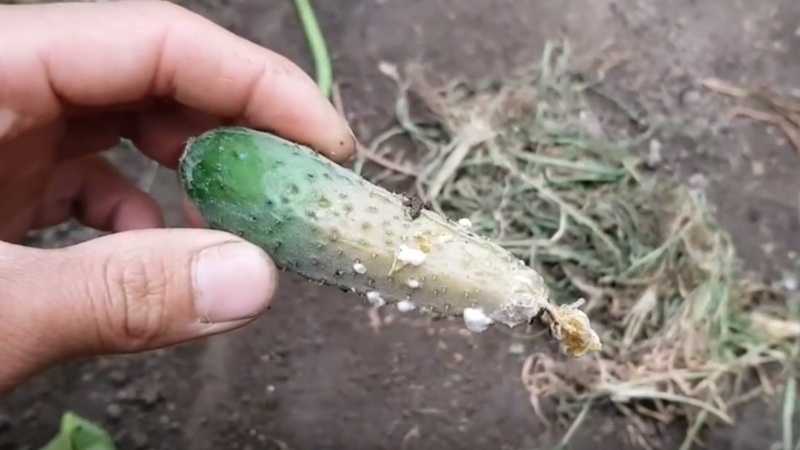
| Recipe | Application |
| 50 g of soda ash, 80 g of copper sulfate, 50 g of soap shavings per 10 liters of water. | Process the bushes 3 times a week. |
| 2 tsp brilliant green, 1.5 tsp. potassium permanganate, 25 ml of liquid soap per 10 liters of water. | Process plants 2-3 times a week. |
| 10 g of boric acid, 1.5 g of potassium permanganate, 30 ml of iodine, 50 g of soap shavings per 10 liters of water. | Process planting 3-4 times a week. |
The table shows popular anti-gray rot chemicals:
| Name | Application | Toxicity |
| "HOM" | Dissolve 40 g of powder in 10 l of water, add 100 ml of skim milk. Spray once a week in the evening. | Not toxic to humans and insects. |
| "Rovral" | The powder is mixed with lime or chalk in a 1: 1 or 2: 1 ratio and the infected stems are coated 3 times a month. | |
| "Euparen Multi" | 0.2% solution is used to treat bushes once every 14 days. |
White mosaic
White mosaic is a viral disease. Signs develop according to the scheme:
- highlighting areas along the veins;
- spots in the form of stars and yellow rings;
- overgrowth of white spots with a yellowish tinge on foliage and fruits.
There are no effective treatments for a viral disease. The diseased plant is completely removed from the site and burned.

Ascochitosis
Ascochitosis - a dangerous fungal disease that causes the gradual death of the bush. The spread of the fungus begins from the stem, without affecting the leaves, so the plant remains viable for some time. Leaves are affected at the beginning of the fruiting period.
Signs:
- vague spots on the edges of the leaf blade of brown and then whitish color with a yellow tint;
- raised areas on spots with spores inside;
- drying and dying off of leaves.
What if the cucumbers are covered with a white coating? The fungus that causes ascochitis is not able to multiply in the soil. The pathogen is found on the seeds of the cucumber. Therefore, the main measure to prevent the disease is pre-sowing disinfection of seed with fungicides.
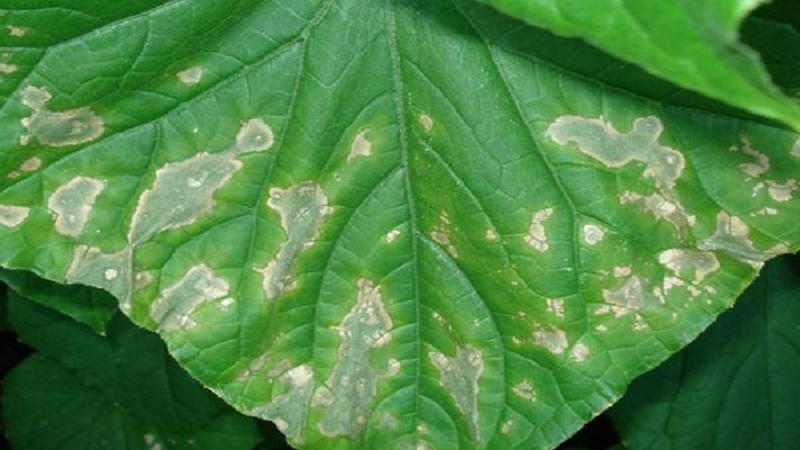
The table shows preparations for treating cucumber seeds before sowing.
| Name | Application |
| "Baxis" | Soak seeds for 2 hours in 0.2% suspension. |
| "Planriz" | Soak seeds for 6 hours in 1% solution. |
| "Fitosporin-M" | Soak seeds for 2 hours in working solution. |
There are no folk remedies to combat ascochitis.
Spider mite
The spider mite feeds on plant tissues. It affects the planting of cucumbers in open and closed ground.
The main sign of its presence is small white dots on the back of the leaves. Later, a thin cobweb envelops the foliage.
With severe damage, the leaves turn white from numerous injuries. Hordes of spider mites are visible on the stems.
Chemicals are used in extreme cases, when traditional methods have failed. Insecticides quickly destroy pests, but they are toxic to humans and the environment. Another disadvantage of such treatments is the rapid development of insect resistance. Therefore, it is recommended to change the preparations every 2-3 sprays.
Spraying is carried out in the evening to prevent sunburn on the leaves.
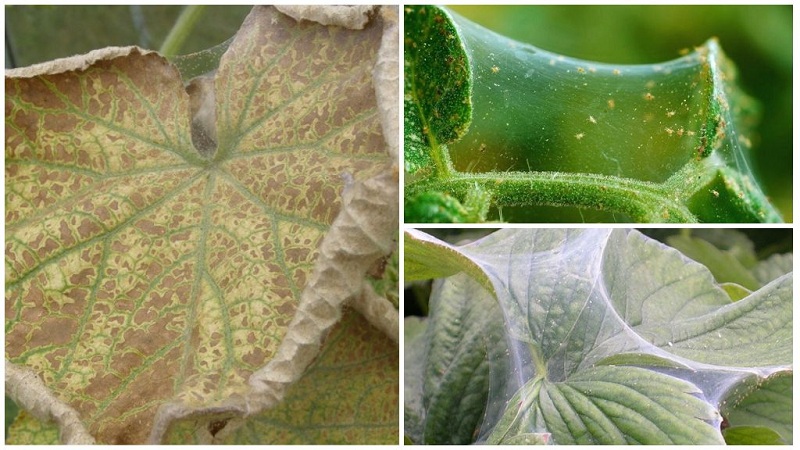
The table shows effective insecticides. Chemical treatment is stopped 20 days before the start of harvest.
| Name | Application | Protection period | Processing frequency |
| "Plant-pin" | The drug is released in the form of sticks, which are immersed in the ground next to the bushes. | 1.5 months | 1 |
| "Karbofos" | 70 g per 10 liters of water, consumption - 0.5 liters per bush. | 7 days | 2 |
| Flumite | 5 ml per 10 l of water, consumption - 1 l per plant. | 30 days | 1 |
| "Actellik" | Suspension with a high toxicity class. It is considered the best drug for spider mites.
Dilute 2 ml in 2 liters of water and use immediately. Consumption - 2 liters per 10 sq. m. |
10-12 days | 2 |
The table contains folk remedies to combat the pest.
| Recipe | Application |
| Pour 0.5 buckets of potato tops with water, leave for 5-7 hours, add 50 g of soap shavings. | Spray planting once a week. |
| Insist 30 g of dandelion roots in 1 liter of water for 5 hours. | Process cucumbers 2 times a week. |
| Insist 1 kg of hogweed in 10 liters of water for 24 hours. | Process plantings once a week. |
| Insist 2 heads of garlic in 1 liter of water for a week, dilute 1: 2 with water before use. | Spray the bushes 1-2 times a week. |
| Insist 100 g of ordinary dope in 1 liter of water for 10-12 hours. | Spray the cucumbers once a week. |
| Insist 100 g of dry creeping mustard in 1 liter of water for 12 hours, dilute with water 1: 2 before use. | Process the bushes every 7-10 days. |
Prevention
Measures to prevent white plaque on cucumbers:
- Timely harvesting of weeds and plant residues.
- Compliance with crop rotation. Cucumbers are best planted after cabbage, legumes, corn, onions, and garlic.
- Pre-planting treatment of the site with biological products "Alirin-B" and "Gamair".
- Disinfection of the wells with a hot solution of potassium permanganate.
- Control of nitrogen content in soil.
- Planting varieties and hybrids of cucumbers resistant to fungal diseases.
- Sparse planting of seedlings.
- Preventive treatment of plantings with "Fitosporin", "Kuprolux", "Ordan".
- Selecting a site in a sunny place without drafts.
- Fertilization with potassium and phosphorus.
- Sprinkling instead of overhead to prevent water retention on foliage.
- Frequent loosening of the beds.
- Disinfection of greenhouses with sulfur checkers.
- Control of humidity in the greenhouse (above 80-85%).
- Air temperature control (optimal - + 25 ... + 27 ° С).
- Replacement of the top layer of soil.
Conclusion
White bloom on cucumbers appears due to fungi that cause powdery mildew, downy mildew, ascochitis, gray and white rot. The chemical preparations "HOM", "Oksikhom", "Ridomil Gold", "Acrobat MC", "Alirin B", "Ordan" are effective against them. Folk remedies based on onion peel, tobacco dust, soda ash, milk, fermented milk products, iodine, brilliant green, marigolds, yarrow are effective at an early stage of disease development and prevention.
There are no drugs against viral white mosaic. It is important to follow the rules of agricultural technology to prevent infection.
To combat spider mites use insecticides "Actellik", "Karbofos", "Plant-pin", "Flumite". Folk remedies are used as auxiliary methods of pest control.